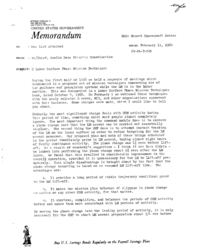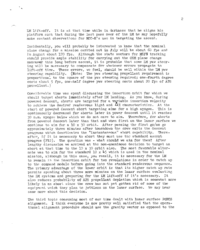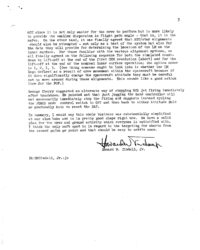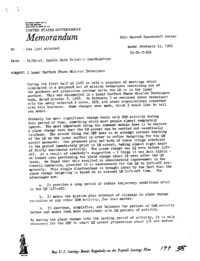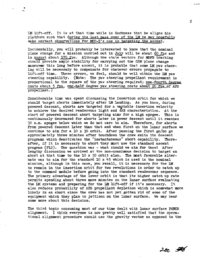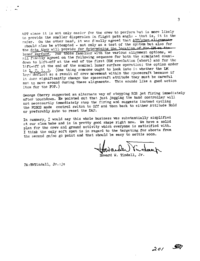See list attachedFebruary 11, 196969-PA-T-22APA/Chief, Apollo Data Priority CoordinationG Lunar Surface Phase Mission Techniques
During the first half of 1968 we held a sequence of meetings which culminated in a proposed set of mission techniques concerning use of the guidance and propulsion systems while the LM is in the lunar surface. This was documented in a Lunar Surface Phase Mission Techniques book, dated October 6, 1968. On February 5 we reviewed these techniques with the newly selected G crews, MIT, and other organizations concerned with this business. Some changes were made, which I would like to tell you about.
Probably the most significant change deals with CSM activity during this period of time, something which most people almost completely ignore. The most important thing the command module does is to execute a plane change such that the LM ascent can be carried out essentially in-plane. The second thing the CMP does is to attempt sextant tracking of the LM on the lunar surface in order to refine targeting for the LM ascent maneuver. Our proposed plan had both of these things scheduled in the period immediately prior to LM ascent, taking almost eight hours of fairly continuous activity. The plane change was 1¼ revs before lift- off. As a result of somebody's suggestion – I think it was Buzz Aldrin – we looked into performing the plane change about 2¼ revs after the LM lands. We found that this resulted in considerable improvement in the overall operation, provided it is unnecessary for the LM to lift-off pre- maturely. This single disadvantage is brought about by the fact that the plane change targeting is based on an assumed LM lift-off time. The advantages are:
a. It provides a long period of stable trajectory conditions prior to the LM lift-off.
b. It makes the mission plan tolerant of slippage in plane change execution or any other CSM activity, for that matter.
c. It shortens, simplifies, and balances the periods of CSM activity better and makes them more consistant with LM periods of activity.
By moving the plane change into the landing period of activity, it is only necessary for the CMP to start LM ascent preparation about 3/4 rev before LM lift-off. It is at that time while in darkness that he aligns his platform such that during the last pass over of the LM he may hopefully make sextant observations for MCC-H's use in targeting the ascent.
Incidentally, you will probably be interested to know that the nominal plane change for a mission carried out in July will be about 60 fps and in August about 170 fps. Although the state vectors for MSFN tracking should provide ample stability for carrying out the CSM plane change maneuver this long before ascent, it is probable that some LM yaw steering will be necessary to compensate for whatever errors propagate to lift-off time. These errors, we feel, should be well within the LM yaw steering capability. (Note: The yaw steering propellant requirement is proportional to the square of the yaw steering required; one-fourth degree costs about 5 fps, one-half degree yaw steering costs about 20 fps of APS propellant.)
Considerable time was spent discussing the insertion orbit for which we should target aborts immediately after LM landing. As you know, during powered descent, aborts are targeted for a variable insertion velocity to achieve the desired rendezvous light and ΔH characteristics. At the start of powered descent abort targeting aims for a high apogee. This is continuously decreased for aborts later in powered descent until it reaches 30 n.m. apogee below which we do not care to aim. Therefore, for aborts from powered descent later than that and when first on the lunar surface we continue to aim for a 10 x 30 orbit. After passing the first go/no go approximately three minutes after touchdown the crew exits the descent programs which deactivates the “instantaneous” abort capability, There- after, if it is necessary to abort they must use the standard ascent program (P12). The question was – what should we aim for then? After lengthy discussion we arrived at the non-unanimous decision to target an abort at that time to the 10 x 30 orbit also. The most favorable alter- nate was to aim for the standard 10 x 45 which is used in the nominal mission, although in this case, you recall, it is necessary for the LM to remain in the insertion orbit for two revolutions in order to catch up to the command module before going into the standard rendezvous sequence. The primary advantage of the lower orbit is that its higher catch up rate permits spending about three more minutes on the lunar surface evaluating the LM systems and preparing for the LM lift-off if it's necessary. It also reduces probability of APS propellant depletion which is somewhat more likely in an abort since the crew has not yet gotten rid of some of the equipment which they plan to jettison on the lunar surface. We may hear some more about this decision.
The third topic consuming most of our time dealt with lunar surface PGNCS alignment. I think everyone is now pretty well satisfied that the opera- tional alignment procedure should use the gravity vector as opposed to the AOT since it is not only easier for the crew to perform but is more likely to provide the smaller dispersion in flight path angle – that is, it is the safer. On the other hand, it was finally agreed that AOT/star alignments should also be attempted – not only as a test of the system but also for the data they will provide for determining the location of the LM on the lunar surface. For those familiar with the various alignment options, we all finally agreed on the following sequence for both the simulated count- down to lift-off at the end of the first CSM revolution (abort) and for the lift-off at the end of the nominal lunar surface operation; the option order is 1, 2, 1, 3. (One thing someone ought to look into is whether the LM legs deflect as a result of crew movement within the spacecraft because if it does significantly change the spacecraft attitude they must be careful not to move around during these alignments. This sounds like a good action item for the FOP.)
George Cherry suggested an alternate way of stopping RCS jet firing immediately after touchdown. He pointed out that just jogging the hand controller will not necessarily immediately stop the firing and suggests instead cycling the PGNCS mode control switch to Off and then back to either Attitude Hold or preferably Auto to reset the DAP.
In summary, I would say this whole business was substantially simplified at our clam bake and is in pretty good shape right now. We have a solid plan for the crew and ground activity which everyone is satisfied with. I think the only soft spot is in regard to the targeting for aborts from the second go/no go point and that should be easy to settle soon.
- Apr 04, 1968 – Mission techniques for the LM lunar stay go/no go (4.5σ)
- Jul 16, 1968 – Lunar Ascent preparation (4.2σ)

